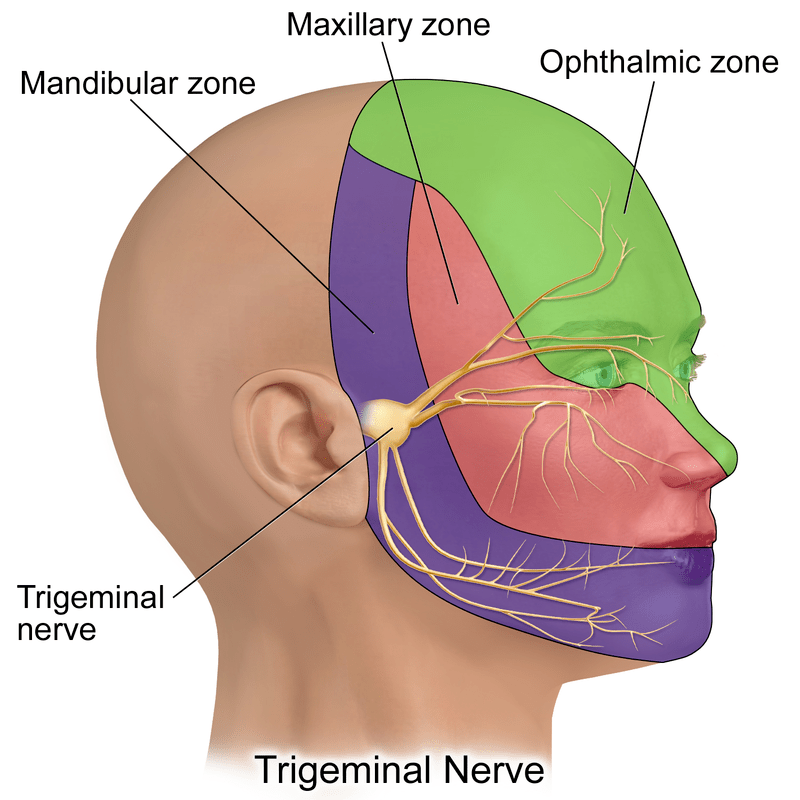Difference Between TMJ and Trigeminal Neuralgia
Table of Contents
The key difference between TMJ and trigeminal neuralgia is that in TMJ, the pain is in the temporomandibular joint whereas, the pain in trigeminal neuralgia occurs within the entire distribution of the trigeminal nerve.
Facial pain is a worrisome condition for a majority of the patients. TMJ and trigeminal neuralgia are the two most common causes of facial pain. Trigeminal neuralgia is a condition caused by the compression of the trigeminal nerve in the peripontine territory, giving rise to facial pain in the area of distribution of the trigeminal nerve.

CONTENTS
1. Overview and Key Difference
2. What is TMJ
3. What is Trigeminal Neuralgia
4. Side by Side Comparison – TMJ vs Trigeminal Neuralgia in Tabular Form
5. Summary
What is TMJ?
Conditions such as giant cell arteritis, abnormalities of bite and tooth grinding are the usual cause of TMJ or Temporomandibular joint pain. Tooth grinding is common in patients suffering from psychiatric disorders or anxiety disorders. The pain may be only in one joint or may involve both joints.

Figure 01: Trigeminal Nerve
Management
Dental correction of the abnormality is the usual treatment to manage the pain though it has not been proven to be effective. Medical professionals may also prescribe Tricyclic antidepressants when there is no obvious dental malformation or abnormality.
What is Trigeminal Neuralgia?
The compression of the trigeminal nerve in the peripontine territory, usually by a dilated vascular loop, gives rise to facial pain in the area of distribution of the trigeminal nerve. Young patients with trigeminal neuralgia, multiple sclerosis, or cerebellopontine angle face the risk of tumors.
Clinical Features
- Episodes of electric shock-like or knife-like pain in the distribution of the trigeminal nerve. Pain usually begins in the mandibular region and lasts for several seconds; it then gradually subsides, but only to recover after a refractory period of variable duration.
- Actions such as washing and shaving can trigger pain.

Management
Carbamazepine is the usual drug that relieves the pain. Lamotrigine and gabapentin are the other options. The failure of the drugs to induce remission is an indication for the surgical interventions to relieve the compression of the trigeminal nerve. The recent advancement of the bioengineering technology has paved the way for the microvascular decompression of the pressure on the nerve.
What are the Similarities Between TMJ and Trigeminal Neuralgia?
- Both are conditions that cause facial pain.
What is the Difference Between TMJ and Trigeminal Neuralgia?
TMJ vs Trigeminal Neuralgia | |
| Causes of temporomandibular joint pain are usually conditions such as giant cell arteritis, abnormalities of bite, and tooth grinding. | Cause of trigeminal neuralgia is the compression of the trigeminal nerve in the peripontine territory, which give rise to facial pain in the area of distribution of the trigeminal nerve. |
| Pain | |
| Pain is present only in the temporomandibular joint. | Pain is present usually in the entire distribution of the trigeminal nerve. |
| Clinical Features | |
| There is an aching pain in the temporomandibular joint either unilaterally or bilaterally. The movements of the joints aggravate this pain. |
|
| Management and Treatment | |
|
|
Summary – TMJ vs Trigeminal Neuralgia
TMJ and Trigeminal neuralgia are probably the two commonest causes of facial pain. The key difference between TMJ and trigeminal neuralgia is that in TMJ, the pain is only in the temporomandibular joint, whereas in the other condition, the pain spreads throughout the distribution of the trigeminal nerve.
Reference:
1. Kumar, Parveen J., and Michael L. Clark. Kumar & Clark clinical medicine. Edinburgh: W.B. Saunders, 2009.
Image Courtesy:
1. “Trigeminal Nerve” By BruceBlaus – Own work (CC BY-SA 4.0) via Commons Wikimedia
2. “513529” (cc0) via Pixabay
ncG1vNJzZmivp6x7pbXFn5yrnZ6YsqOx07CcnqZemLyue8OinZ%2Bdopq7pLGMm5ytr5Wau27AzKNkmqaUYsGztcaepKKmkaF6r7HUq5iln5mWfA%3D%3D